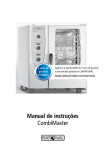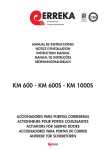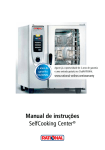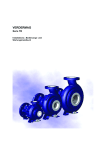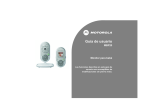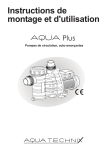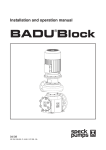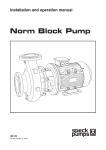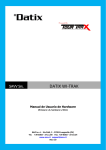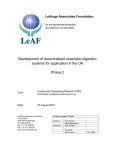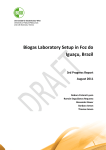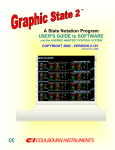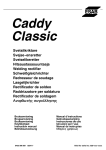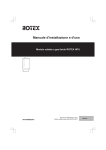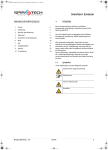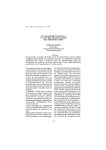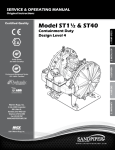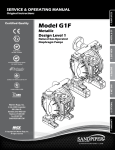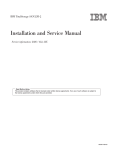Download Verdermag manual
Transcript
VERDERMAG U Series Installation, Operating and Maintenance Manual U Series January 2010 Index 1.0 PREFACE 5.0 COMMISSIONING 1.1 VERDER the Company 5.1 Preparation before Operation 1.2 Product Information 5.2 Commissioning Procedure 1.3 Guarantee 6.0 OPERATION NOTES 2.0 Safety Instructions 7.0 MAINTENANCE 2.1 Basic Do’s and Don’ts 7.1 Preventive Maintenance 2.2 General Instructions 7.2 Bearing Wear Chart 2.2.1 Receiving the pump 7.3 General Assembly/Disassembly 2.2.2 Pump Identification 7.4 Customer Services 2.3 Installation and Operation Instructions 7.5 Notification Of Return Of Goods Form 2.3.1 Piping 7.6 TROUBLESHOOTING 2.4 Maintenance and Repair Instructions 8.0 ATEX 3.0 STORAGE 8.1 Certificate 4.0 INSTALLATION 8.2 Risk assessment U Series January 2010 1.0 PREFACE 1.1 The VERDER Group The VERDER Group is comprised of technical trading and production companies with offices in Austria, Belgium, England, France, Germany, Holland, Hungary, Romania, the Czech and Slovak Republics and the USA. Group Headquarters is in Holland, with a staff of approximately 300 people worldwide, of which 20 are employed by production works, together with a network of distributors in the USA, South Africa and the Far East, selling pumps and other supplies from more than thirty foreign suppliers as well as marketing VERDER Group Products. The access of VERDER resources has enabled the generation of new products, enabled the VERDERFLEX range of peristaltic tube pumps, which are manufactured by VERDER for the Group. This new pump range is typical of Verder product development. After supplying tube pumps to industry for many years, and using the knowledge gained of both the shortfalls of products within the sector and requirements of the end-users, VERDER has developed a pump that will fulfil all the needs of the user. The VERDER Group can be divided into 3 separate divisions: • Pumps and liquid handling • Solids handling • Hot air and Plastics technology Important market sectors for these divisions include the (petro) chemical, food, pharmaceutical and plastics industries, together with wastewater and environmental sectors. Worldwide, the VERDER Group markets all products wherever possible under its own brand, and strives to maintain quality standards based upon ISO 9000 standards, some of the VERDER companies already being accredited with ISO 9001/9002, and others proceeding towards this goal. The shortest possible production chain between manufacture, order and supply is the trading philosophy of the VERDER Group - ensuring the best service possible to end-users, as well as the most cost effective price. This has been achieved by joint ventures with manufacturers for supply of products into specific areas, (these then carry the Verder label); participation in companies who are manufacturers or suppliers for the group. Foresight in implementing this business structure has meant that cost and purchasing advantages can be passed on to the customers in the form of competitive pricing. Major benefits are also achieved implementing technical or dealing with warranty / guarantee requirements. VERDER Group recognises its responsibilities to its worldwide customers, and will always seek to meet or exceed their expectations. 1.2 Product Information VERDERMAG, manufacturer of VERDERMAG Zero Leakage Centrifugal pumps, magnetically coupled seal-less pumps for pumping and transportation of liquids and chemicals, both in metallic and non-metallic construction. VERDER also manufactures the VERDERFLEX range of peristaltic tube pumps. This manual refers in detail to the VERDERMAG non metallic Zero Leakage Centrifugal Pumps. The TB pumps are for those applications which fall below ISO norms and are manufactured to Verder’s own standard. For motor specification and safety instructions, please refer to motor manufacturers details in the data dossier (where applicable). EMPO-VERDER is located in Aartselaar, Belgium. Address, telephone and fax number details are listed on the back cover of this manual. U Series January 2010 1.3 Guarantee All VERDER pumps are warranted to the original user against defects in workmanship or materials under normal use (rental use excluded) for two years after purchase date. This warranty does not cover failure of parts or components due to normal wear, damage or failure that in the judgment of VERDER arises from misuse. Warranty will not be accepted on any unit where the unit has been disassembled prior to return without the express permission of VERDER. Parts determined by VERDER to be defective in material or workmanship will be repaired or replaced. Limitation of liability: To the extent allowable under applicable law, Verder’s liability for consequential damages is expressly disclaimed. Verder’s liability in all events is limited and shall not exceed the purchase price. Warranty disclaimer: VERDER has made an effort to illustrate and describe the products in the enclosed brochure accurately; however, such illustrations and descriptions are for the sole purpose of identification and do not express or imply a warranty that the products are merchantable, or fit for a particular purpose, or that the products will necessarily conform to the illustration or descriptions. Product suitability: Many regions, states and localities have codes and regulations governing the sale, construction, installation and/or use of products for certain purposes, which may vary from those in neighbouring areas. While VERDER attempts to assure that its products comply with such codes, it cannot guarantee compliance, and cannot be responsible for how the product is installed or used. Before purchasing and using a product, please review the product application as well as the national and local codes and regulations, and be sure that product, installation, and use complies with them. 2.0 Safety Instructions Protect yourself, and your newly U-mag pump, by following accepted engineering practices in the installation, operation and maintenance of this equipment. Listed below are some of basics you should keep during mind in addition to your own company rules regarding installation, operation and maintenance: • NEVER start this pump without proper prime (casing must be full of liquid). • NEVER run this pump dry. • NEVER operate this pump with the suction valve closed. • NEVER operate this pump with the discharge valve closed. • NEVER use heat (risk of explosion) to disassemble any portion of the pump. • NEVER change pumps conditions of service without approval of Distributor or Innovative MagDrive. • NEVER remove “Warnings” labels that are displayed on the pump. • NEVER operate pump if there are question signs of leakage. • NEVER loosen flange connection while system is under pressure. • ALWAYS remove casing drain and purge casing of liquid before service. • ALWAYS keep a clean work environment. • ALWAYS perform “Tag & Lockout” on power source before service. • ALWAYS make certain pressure gages, indicating lights and safety devices are in working order. • ALWAYS know the EMERGENCY STOP for this pump. U Series January 2010 • ALWAYS have this service manual available during any installation or maintenance. • NEVER attempt to clean the pump while it is operating. • ALWAYS perform “Tag & Lockout” on power source before cleaning. • ALWAYS remove casing drain and purge casing of liquid before cleaning internals. • ALWAYS make certain that no toxic or flammable fumes and/or vapors remain in the pump casing or surrounding area. • ALWAYS clean up any spills immediately according to local, state and federal codes. • ALWAYS have this service manual available during installation and maintenance. 2.1 Basic Do’s and Don’ts The following are DO’s and DONT’S related to magnetic drive pumps. Common rules such as no cavitation, or no opposite rotation apply to this pump. For your protection, and the protection of others, learn and always follow the safety rules outlined in this booklet. Observe warning signs on machines and act accordingly. Form safe working habits by reading the rules and abiding by them. INSTALLATION, OPERATION AND MAINTENANCE MUST BE DONE BY THOROUGHLY QUALIFIED PERSONNEL IN STRICT ACCORDANCE WITH THIS MANUAL AND MUST COMPLY WITH ALL LOCAL, STATE AND FEDERAL CODES. Keep this booklet handy and review it from time to time to refresh your understanding of the rules. VERDERMAG has designed this pump for safe and reliable operation. However, like any mechanical device, the proper and safe performance of this equipment depends upon using sound and prudent operating, maintenance and servicing procedures performed by properly trained personnel. Instructions and safety procedures contained herein must always be followed. As such, VERDERMAG shall not be liable for any damages or delays caused by failure to observe any instructions or warnings in this manual. DANGER The use of the word “DANGER” always signifies an immediate hazard with a high likelihood of severe personal injury or death if instructions, including recommended precautions, are not followed. CAUTION The use of the word “CAUTION” signifies possible hazards or unsafe practices which could result in minor injury, product or property damage if instructions and recommended precautions are not followed. WARNING The use of the word “WARNING” signifies the presence of hazards or unsafe practices which could result in severe personal injury or death if instructions, including recommended precautions, are not followed. U Series January 2010 MAGNETIC The use of the word “MAGNETIC” indicates the persistent presence of a magnetic field. Such fields present immediate danger to individuals having electronic medical devices, metallic heart valves, metallic prosthetics or metallic surgical clips. Caution 1. Reed switches - people who are assisted by electronic devices that may or may not contain reed switches should not handle magnetic pumps or their parts. Pacemaker and implantable defibrillators are examples of these devices. The magnets used in this pump are some of the strongest available in the world. 2. No hands or fingers should be placed between the magnets. 3. Do not put magnetic field sensitive items such as credit cards, floppy diskettes or magnetic tapes near magnets. 4. No steel or iron tools near the magnets. Steel tools such as wrenches and screwdrivers are easily attracted by the magnets and can break them on contact. 5. Liquid poured in casing for initial priming must be compatible to incoming liquid. 2.2 General Instructions Warning: Pumps must always be accessible for operation and maintenance; passageways should not be locked or blocked. Warning: If dangerous or unknown substances have been used in the pump before maintenance and repair work, always empty and clean the pump. Read the safety instructions as mentioned in the chemical data booklet. Warning: When pumping dangerous substances, ensure compatible materials of construction are used. Warning: When returning used pump units they must be accompanied by relevant COSHH and completed copy of the returns documentation, enclosed in maintenance manual (original to be kept with the manual). 2.2.1 Receiving the pump All VERDERMAG pumps are inspected prior to shipping and protectively crated for safe transportation. VERDERMAG cannot, however, guarantee the safe arrival at the user’s plant. Upon receipt of this equipment: • Compare the received items and the packing list to check for missing parts or damage. • Check the packing material thoroughly for small parts. U Series January 2010 If any parts are missing or if the pump is damaged a claim must be filed against the carrier immediately. Pump ends without motors require assembly of the outer magnet drive and motor. Refer to drive end assembly procedures in the manual. Warning: Failure to properly lift and support equipment could result in serious injury to personnel or damage to pumps. Warning: These pumps use ceramic silicon carbide components. Do not drop pump or subjecti it to shock loads, this may damage internal ceramic components. 2.2.2 Pump Identification Every VERDERMAG pump unit has a nameplate located on the side of the casing. It is recommended that the purchaser record the serial number and reference it when requesting information or service parts from VERDERMAG. The serial number , must be used for all correspondence and spare parts orders. Empo-Verder NV Belgium www.empo-verder.be U Series January 2010 U-MAG, PUMP IDENTIFICATION CODE Wet End U0 146 1 1 1 0 U-mag Models impeller diameter Size Min Max U0 (1.5x1x5") 3.25" 5,75" (40x25x127mm) 76 146 U1 (2x1,5x6") 3,25" 6,13" (50x40x152mm) 76 156 U2 (1x1x6") 3.25" 6,13" (25x25x152mm) 76 156 U3 (3x2,5x6") 4,5" 6,13" (80x65x152mm) 76 156 0 - Drive End U B 0 Option 1 0 N/A Impeller Diameter 146 mm ( to be advised, depending on application) Bearing System Bushing 1 Sintered SiC Motor Frame IEC B5 M 80 N 90 Q 100/112 7,5 kW @3000 rpm max R 132 7,5 kW @3000 rpm max Pump Shaft Sintered SiC Wear Ring/Thrust Collar Impeller Casing 1 Sintered SiC Sintered SiC Containment Shell Sintered SiC Gasket 1 FEP/Viton Flanges 0 ANSI/ISO/JIS (Universal slotted holes) Construction Impeller Body 0 CF-TEFZEL 1 CF-TEFZEL 2 TEFLON PFA 3 TEFLON PFA U Series Product Group U U-Mag Casing Casing Lining Drain No DI/TEFZEL Yes DI/TEFZEL DI/PFA No DI/PFA Yes Containment Shell Lining/Composite CF-TEFZEL/Kevlar CF-TEFZEL/Kevlar TEFLON PFA/Kevlar TEFLON PFA/Kevlar January 2010 2.3 Instruction for Installation and Operation Warning: When connecting the motor to the power supply, pay attention to the rotation of direction for the pump, as indicated. Check the power supply with the information on the tag-plate of the motor and set the thermal safety guards, in accordance with the instructions provided by the motor supplier. Warning: The pump may, due to testing in the factory or workshop, still contain water remnants. With substances that cannot come into contact with water, remove the water before operation. Where possible, flush the pump with the liquid to be pumped followed by airdrying. (A mag-drive centrifugal pump must not be allowed to run dry). Warning: When pumping with a centrifugal pump, ensure that the valves in both the discharge and suction lines are open. Warning: The pump must be installed in such a way to eliminate vibrations. Suction and discharge pipes always need to be constructed so that a stress-free connection is guaranteed. Warning: Use the correct connections at the suction and discharge ends of the pump. Use the correct pipe diameter; reduction of the diameter is not recommended due to the high pressure created at the pump discharge. Tip: When pumping extremely aggressive or dangerous liquids, it is recommended to have a vent to the storage tank. We would strongly advise that in these circumstances you install a discharge and suction valve. 2.3.1 PIPING General VERDERMAG pumps are designed with all the necessary strength factors for long, reliable service life. Some general guidelines are described here for your pump installation needs. It is good practice to install a throttling type shut- off valve in the discharge piping. Throttling the discharge during initial start-up is recommended to protect against “water hammer,” which is most likely to happen when there are long pipe runs at high flow velocity. • Piping should be arranged to allow pump flushing prior to removal of the unit if handling corrosive liquids. • When Teflon or similar lined pipe is used, flange alignment should be carefully checked. Spacer ring gaskets are recommended to assure parallel alignment of pipe and pump flanges. The following flange bolt torque values should be used: 1-1/2” (12-16 Nm) ; 2” (24-32 Nm) ; 3” (31-40 Nm); 4” (36-49 Nm) • Piping should be supported independently of the pump and line up naturally to pump flanges. U Series January 2010 • Pressure gages should be installed in both the suction and discharge piping. The gages will enable the operator to easily observe the operation of the pump, and to determine if the pump is operating in conformance with the performance curve. If cavitation or other unstable operation should occur, widely fluctuating discharge pressures will be noted. Suction Piping If Reducers are used they should be eccentric and installed at the pump suction flange with eccentric side on the bottom. The length of the suction pipe should be kept to a minimum. Suction piping should be installed with a gradual rise to the pump to eliminate any air pockets. The diameter of the suction pipe should always be as large or larger then the pump suction. Elbows or fittings should be avoided at suction flange. Allow at least 10 pipe diameter in length for straight run into the pump. If a value is used in the suction, use only full flow valves. These valves should be for shut-off only when the pump is not running, not for throttling or controlling flow. A valve designed for flow control should be installed in the discharge. This valve line can be used for throttling. Suction strainers, when used, must have a net free area of the least three times the suction pipe area. An isolation valve should be installed in the suction line at least two pipe diameters from the suction to permit closing of the line for pump inspection and maintenance. Isolation and check valves should be installed. Discharge Piping In the discharge line the isolation valve allows for regulation of the flow and for inspection of the pump. The check valve prevents pump damage by water hammer. Electrical Danger: Only a qualified electrician should make the electrical connections to the pump drive motor. Thoroughly read motor manufacturers instructions before making installation. Check motor nameplate data to be certain that all wiring, switches, starter, and overload protection are correctly sized Install the motor according to local electrical codes. Check all connections to motor and starting device with wiring diagram. Check voltage, phase, and frequency on motor nameplate with line circuit. Install a flexible electrical coupling on the motor. Allow for movement of at least 300mm. This is necessary to service and inspect the pump. U Series January 2010 Start-Up 1) Fully open the suction valve. Pump requires a flooded suction. Warning: Do not operate pump with suction valve closed. Operating pump more than a few minutes with the suction valve closed can cause bearing failure. 2) Open the discharge valve. VerderMag pumps operate safely with the discharge valve partially open. Caution: Continous operation against a closed discharge valve may cause pump to overheat 3) Briefly jog the motor long enough to determine the direction of rotation. Correct rotation viewed from the suction port is CCW as indicated by the arrow on the front of the casing. Improper rotation will not damage the pump , but performance will be greatly reduced. 4) Start the pump. Caution: Immediately check pressure gauges. If discharge pressure is not quickly reached stop the driver, reprime and attempt to restart. Pump Performance 1) Set flow rate and pressure by regulating the discharge valve. Caution: Never throttle pump using the suction valve. 2) Check the pump and piping to assure that there are no leaks 3) Check and record pressure gage readings for the future reference. Caution: Never operate pump above rated temperature of 121°C Never operate pump above rated pressure 20 bar Never operate: below minimum flow rates. (Refer to table 1) VERDERMAG recommends the use of a power monitor to prevent pump damage under atypical operating conditions. Warning: Driver may overload and de-couple if pumpage specific gravity is greater than originally specified Prolonged running while de-coupled will damage the driver magnets. (Refer to Table 1). U Series January 2010 Tabel 1 Model Connections Suction Discharge Flow - m3/h Min. Max. BEP Temp. H(m) Q(L/min) °C Motor Max. kW U25-125 DN 40 DN 25 0.2 22 25 220 121 7.5 U40-160 DN 50 DN 40 0.2 32 31 350 121 7.5 U25-160 DN 25 DN 25 _ _ _ _ 121 7.5 U65-160 DN 80 DN 65 0.2 83 6 1000 121 7.5 U Series January 2010 2.4 Instructions for Maintenance and Repair Work Warning: Capable suitably trained and authorised personnel should only carry out the maintenance and repair work of “VerderMag” centrifugal pumps. Warning: If dangerous or unknown substances have been used in the pump prior to maintenance and repair work, always clean the pump first. Warning: Ensure when the pump has been operated at extremes of temperatures that is has reached safe limits before handling. Warning: When pumping dangerous or unknown liquids, protective clothing (glasses, gloves, etc.) should always be worn. Warning: Before working on the pump you must first release the pressure from the discharge pipe. Always empty and clean the pump. Always check the safety instructions referring to the pumped liquid. Danger: Before commencing any pump maintenance, ensure the power supply is disconnected from the driver (turn off the main power). Check the pump is free of pressure. During maintenance and repair work be sure that no unauthorized personnel can operate the pump. Tip: Only return pumps when cleaned. Tip: If you have any questions and/or remarks please contact Verder. Warning: not change or alter the pump, drive or pump connections without consulting Verder. Do not alter the mounting position. No obligations can be met when the aforementioned is not taken into account. Do 3.0 Storage 1. If the pump unit is not to be used immediately, it should be stored carefully in a horizontal position, in a sheltered, dry location. 2. Closure's fitted over suction and discharge openings must remain in position. Bearings and coupling if fitted must be carefully protected against dust, grit and other foreign matter. 3. A rust preventative should be applied to all unpainted carbon steel or cast iron parts, and should not be removed before final installation. 4. For long term storages pumps should be rotated by hand at least five revolutions every two months. U Series January 2010 5. For extreme variants in atmospheric temperature/conditions we reserve the right to modify the aforementioned storage instructions. 4.0 Installation The magnets used to drive the pump are very powerful. Care should be taken when handling both the outer and inner magnets during disassembly and assembly. Completely close both discharge and suction valves before assembly. Be very careful when pumping corrosive liquids. There may be a residue in the pump even after flushing. Remark: Prior to installation, ensure you have knowledge of pumping principles. Warning: Always wear protective clothing and facemasks when handling contaminated or corrosive liquids. Descriptions: 1.Installation Mount the pump on a horizontal base plate ensuring it has sufficient strength and rigidity to support the pump. When mounted on a skid, mate the pump to the system pipework. 2. Foundation The surface should be level. Correctly sized anchor bolts should be used when securing the pump. 3. Piping The suction piping should be as short as possible and with a minimum number of long radius bends and other restrictions. Excessive length and sharp changes in the direction of flow may lead to flow instability and cavitation. The available NPSH should exceed the required NPSH at least 0,5 m. See respective performance curve for the required NPSH. The suction piping should never be smaller than the pump inlet. When pumping viscous or hot liquids, lower flow velocities, and larger pipe diameters are recommended. Mate the pump to the connecting pipework ensuring the pipework is supported independently eliminating any tremors, weight or vibration transmitted from connecting piping to the pump. 5.0 Commissioning 5.1 Preparation before Operation 1. Fully clean the inside of the piping and the pump prior to priming. 2. Retighten the flange connecting bolts and base mounting bolts. If possible, pressure tests your installation. 3. Use the motor fan to turn the motor and check whether or not it turns freely. 4. Completely close the discharge valve. U Series January 2010 5. When the suction condition is under pressure, check the pressure within the suction pipe, and verify that the pump is filled with liquid. Then using the motor fan, rotate the pump to expel the remaining air in the impeller from the pump chamber. 5.2 Commissioning Procedure 1. Close the cocks of the pressure and vacuum gauges. Open the cocks only when measuring and always keep closed after use. 2. Fully open the suction gate valve and partly open the valve on the discharge line. 3. Before starting up, ensure that the piping and wiring are installed correctly. 4. Turn the motor fan by hand and ensure that the pump rotates smoothly. Operate for a few seconds to check that the motor is rotating in the correct direction. An arrow shown on the pump indicates the correct rotating direction. If rotation is incorrect, interchange power source leads of 2 phase terminals. 5. Start the pump. If the pump fails to start, check the wiring to determine the cause of the trouble. 6. Check the discharge pressure and then gradually open the gate valve until the pressure reaches the required level. When the valve is opened excessively, it may cause overload and magnet de-coupling. Check that the required flowrate is obtained. Ensure that minimum safe flow requirements are exceeded. Do not close the valve excessively. If a flow meter is not installed, obtain the value of capacity from the values of pressure gauges, ampere meter and friction loss head. Warning: NEVER let the pump run dry. NEVER let the pump run against closed valve. U Series January 2010 6.0 Operation Notes 1. Dry Running Dry running must be avoided. Before operating, make sure that the pump is primed and vented. Pumping temperature / pressure should ensure the pumped product remains in the liquid phase at all times. 2. Cavitation Cavitation damages the internal pump parts, such as bearing and impeller, or can cause abnormal wear, therefore the pump should be stopped immediately under cavitation running. Do not close the suction gate valve while the pump is in operation. 3. Disassembly of Magnet Coupling If the magnet coupling becomes disconnected due to overload or another reason, stop the pump immediately. If the pump is operated for long periods under this condition, magnet and bearing damage will occur. 4. Variation in Liquid Temperature If the temperature of the liquid varies over the limits of your pump, damage may occur. For specific data on your pump, please see maintenance manual. 5. Electrical Failure When the electric power supply fails, cut the supply to the pump at once and close the discharge valve. 6. Maximum permissible system pressure Ensure the system pressure does not exceed the pressure capabilities of the pump. ATEX 01/03. Failure to operate the pump unit within the specified parameters may result a ‘rare malfunction’-giving rise to the possibility of an effective source of ignition. Reference should be made to the ATEX certificate of conformity and the ignition hazard assessment. This will be incorporated within the Manual. This ATEX certification only applies to the pump head and should be applied in conjunction with the motor certification (not applicable to pump units installed in non hazardous areas). 7.0 Maintenance 7.1 Preventive Maintenance Decommissioning Procedure 1. Gradually close the discharge gate valve. Never close the discharge piping suddenly (e.g. by use of a solenoid valve). It may create water hammer and subsequent pump and/or pipework damage. 2. Shut off the electrical supply monitor if the speed of rotation falls slowly and smoothly. If it is not smooth, check the inside of the pump and the drive magnet for any abnormal condition. 3. When stopping the pump for an extended period, remove all liquid from the pump or keep the pump warm to prevent freezing. 4. Where a standby pump is available, it is recommended that it is used from time to time. An annual overhaul is recommended, however daily maintenance such as inspection of discharge and suction pressure, flowrate, vibration, voltage, noise and the electric motor current is recommended to detect pump failure before any major damage occurs. When any abnormal condition is found, contact you’re nearest agent. U Series January 2010 The preventative maintenance and disassembly procedures are intended for use during standard field inspection or service. The disassembly can take place with the pump still piped in or in a maintenance shop. Warning: Lock out the driver power to prevent accidental start-up that could result in serious personal injury. 1. Lock out and/or disconnect power. 2. Shut off all valves controlling flow to and from the pump. Isolate the pump from the system and relieve any remaining system pressure. Drain and decontaminate the pump in accordance to all federal, state, local and company environmental regulations. All VERDERMAG pumps are equipped with a flanged ½” casing drain. Warning: When handling hazardous and/or toxic fluids, skin, eye and respiratory protection are required. If pump is being drained, precautions must be taken to prevent injury and/or environmental contamination. Warning: MAGNETIC VERDERMAG pumps contain extremely strong magnets. The use of non-magnetic tools and work surface is highly recommended. Tools Required 5 8mm or 5/16” Hex Key (Pump end) 1. Begin pump disassembly by separating the wet end (Lighter Color) from the drive end (DarkerColor).Inspections can take place either piped up or in the maintenance shop. Figure 3: Begin disassembly of Wet/Driver End U Series January 2010 2. Loosen and remove (4) 10 mm socket head cap screws (Item 300) on the Adapter (Item 19). Figure 4: Loosen cap screws 3. To break the magnetic field of the wet/drive end, firmly hold either end and use a quick pulling motion to separate the two. Rotate the driver assembly allowing space for disassembly of the liquid end. Figure 5: Separate wet/driver end Caution The shop area must be clean and free of any ferrous particles. Magnetic Reminder: Keep all metal tools away from magnetic field of the impeller and outer drive assemblies. 4. Set the wet end on a flat surface with suction flange down. Loosen and remove (6) 10 mm socket head cap screws (Item 300) on the Containment Ring (Item 239). U Series January 2010 Figure 6: Loosen wet end cap screws Warning: Each component must be individually decontaminated using procedures in accordance with all federal, state, local and company environmental regulations. Preventative Maintenance Inspection Magnetic Reminder: Keep all metal tools away from magnetic field of the impeller and outer drive assemblies. 1. Firmly hold the containment shell (Item 231) and slowly pull the assembly away from the casing (Item 1). The impeller (Item 2) will remain inside the containment shell by magnetic attraction to the ductile iron containment ring (item 239). Figure 7: Open wet end. U Series January 2010 2. Remove impeller (Item 2). Figure 8: Remove impeller 3. Remove containment shell (Item 231) from containment ring (Item 239). Figure 9: Remove containment shell Visual Part Inspection Visually inspect all pump internals for any wear, cracks, chips or scoring. Use Table 3 for wear limits. Follow procedures in complete assembly section of the manual for replacing wear parts. Figure 10: Containment Shell Assembly U Series January 2010 2. IMPELLER MAGNET ASSEMBLY - Carefully inspect and clean the following viewed in Figure 11: • Wear Ring, Front (Item 8), if material is: CFR-PTFE - Check for wear & abrasion (rule of thumb- replace if lubrication flutes are worn away) SiC - Check for cracks or chips. • Bushing, Bearing (Item 235), if material is: C. Graphite - Check for wear & abrasion SiC - Check for cracks or chips. • Impeller body inspection, check for abrasion, scoring, debris & erosion of leading and trailing edges of vanes.. Figure 11: Impeller Magnet Assembly 3. CASING ASSEMBLY - Carefully inspect and clean the following viewed in Figure 12: • Collar, Front Thrust (Item 72), Check for cracks or chips. • Retaining Ring, Front (Item 9), Check for cracks. • Lining, check for abrasion, scoring & debris. Clean gasket sealing area thoroughly. Figure 12: Casing Assembly U Series January 2010 4. DRIVER END - Carefully inspect and clean the following viewed in Figure 11: • Magnet Assembly, Outer (Item 232), A stainless steel cup protects the magnets from damage. Wipe clean any particles attracted to the magnets. Figure 13: Driver End 7.2 Bearing wear Chart Table 3: Wear Limits U Series January 2010 7.3 Complete Pump Disassembly/Assembly Caution Due to the brittle nature of SiC, all assemblies must be handled with care to avoid chipping or cracking. Warning: When dismantling and reassembling, take care not to trap your finger between magnetic parts because of its high power. Also, do not bring any electronic equipment into the powerful magnetic field around the magnet because problems may occur. Close the suction and discharge valves before disassembly and re-assembly. Ensure the pump is isolated from the power supply. Remove the pump from the pipework installation. The pump will hold a small amount of product and will drain on removal of the casing. The magnetized components, i.e. the pump shaft assembly and the outer rotor assembly must be clean and free of all debris. All threaded components must be coated with anti-seize compound such as copper slip or pcb. New sealing joints should be fitted. The unit must be assembled in a clean area. Note: The inner and outer rotors are magnetic and will attract debris. They must be protected at all times. Tools Required 8 mm or 5/16” Hex Key (Pump end) 1/4” T-Handle Hex Key (Outer Drive) Crescent Wrench (Motor & Base mounting) • Tool kits were created for easy assembly and disassembly of VERDERMAG pumps. Refer to appendix for kit contents and drawings. U Series January 2010 WET END Figure 14: Wet End Parts 1. Place the casing (Item 1) with suction side down on a clean surface. Insert the front thrust collar (Item 72) into the lined casing suction. Align the keyway of both parts as shown in figure 15. Figure 15: Insert Front Thrust Collar U Series January 2010 2. Insert Front Stationary Retaining Ring (Item 9) drive pin into the casing lining keyway. Figure 16: Insert drive pin 3. Press on each wave of the retaining ring while sliding into the casing lining groove. Trim the retaining ring end to meet the drive pin. Optional, to ensure the retaining ring security, stake the ends together. Figure 17: Insert Front Retaining Ring 4. Place the Particulate Control Ring (Item 27) into the containment shell (Item 231) aligning the keyways with drive tabs. Snap the ring into position. Use a rubber hammer to tap ring if necessary. Figure 18: Particulate Control Ring U Series January 2010 5. All U-mag Containment Shells (Item 231) have a built in Rear Thrust Collar (Item 71) and Pump Shaft (Item 6). Use pliers to remove the thrust collar if damaged or worn. Simply snap in a new ring by hand or use an arbor press in combination with rear thrust collar installation tube show in the appendix. Figure 19: Containment Shell Assembly 6. Check Gasket, O-ring (Item 73) for dirt before placing onto the containment shell. Stretch the o-ring into the sealing groove. Figure 20: Gasket, O-ring 7. Place Containment Shell assembly (Item 231) into the Containment Ring (Item 239). Figure 21: Containment Ring U Series January 2010 8. Place Bushing, Bearing (Item 235) into impeller (Item 2) bore aligning keyway with molded key. Once aligned, use Bushing installation tube (see drawing in appendix) and an arbor press to push into position. Figure 22: Assemble Bushing, Bearing 9. Place Wear Ring, Front Rotating (Item 8) into impeller (Item 2) eye aligning keyway with molded keys. Once aligned, use installation tool (see drawing in appendix and an arbor press to push into position. To remove, simply use a pair of pliers to grab and pull our of the socket show below. Figure 23: Assemble Wear Ring, Front Rotating U Series January 2010 10. Place the Impeller Assembly (Item 2) on a clean table or in the Casing suction. Carefully slide the Containment Shell Assembly (Item 231) over the Impeller assembly engaging the shaft and bushing. Figure 24: Assemble Impeller and Containment Shell 11. Place the Containment Ring (Item over the Containment Shell (Item 231). MAGNETIC Reminder: Magnetic attraction will occur with ductile iron ring and impeller magnets. Figure 25: Assemble Containment Ring U Series January 2010 12. Put together the wet end assemblies aligning bolt holes. MAGNETIC Note: Magnetic attraction holds the impeller assembly together with the containment ring/shell assembly. Figure 26: Assemble wet end 13. Align (6) bolt holes on the containment ring and (4) tapped holes for the Driver End assembly as show below. Torque socket head cap screws to required values listed in table 3. Figure 27: Torque Bolts Table 3: Bolt Torque Values U Series January 2010 Tools Required 8 mm or 5/16” Hex Key (Pump assembly) 3/16” T-Handle Hex Key (Outer Drive) Crescent Wrench (Motor & Base mounting) • Driver End Assembly (IEC) Figure 34: IEC Driver End Parts 14. The IEC Adapter (Item 19) will accept motor frames 80 & 90 without additional hardware. Mounting an 100 or 112 frame motor requires (6) dowel pins inserted on the adapters back face. Due to the large diameter C-Face on an IEC 132 frame motor, an additional mounting plate is required. Figure 35: IEC Adapter arrangements U Series January 2010 15. Place the Adapter (Item 19) onto the motor C-Face. Using a crescent wrench, torque the (4) bolts to require values in table 3. Figure 36: Installing IEC Adapter 16. Place the Pump Riser (Item 20) onto the bottom boss of Adapter (Item 19). Some pump sizes require additional spacer blocks. Using a 8mm or 5/16” hex key torque the (4) 10 mm socket head cap screws to required torque indicated in table 3. Figure 37: Installing Pump Riser 17. Slide the Outer Magnet Assembly (Item 232) onto the motor shaft aligning shaft keyway. Add some anti-seize to the Outer Magnet bore for rust prevention. Figure 38: Installing Outer Magnet Assembly U Series January 2010 18. Set the outer magnet assembly depth by positioning the circumferential groove on the outer magnet to the adapters raised face. Use a shim, ruler or screw driver to align the driver. Figure 39: Setting the Outer Drive 19. Remove pipe plug on the side of Adapter to access the set screws. Torque the outer drive magnet to motor shaft using a 3/16” T-Handle Hex Key. Proper torque value is 120 in-lbs. Figure 40: Setting the Outer Drive 20. To remove the new outer magnet assembly, simply grab with two hands and pull. If locked, place 1/2’-13 threaded rod into the jackscrew plate. Secure the plate with two screws, torque and remove. Figure 41: Remove Outer Magnet Assembly U Series January 2010 MAGNETIC Strong magnetic attraction when assembling drive end to wet end. WARNING Keep hands and fingers away from magnets during assembly. Serious injury can result 21. Slowly slide the wet end towards the drive end. Tighten the (4) M10 socket head cap screws to torque values in Table 3. Figure 42: Assemble Pump 22. Complete U-mag Pump. Figure 43: Assembled Pump U Series January 2010 Pump Item List U Series January 2010 Item Qty Part Name 1 1 Casing 2 Item 8 1 Impeller Magnet Qty Part Name 1 Wear Ring, Front Material Ductile Iron/ETFE Lining Product Group/Size or Description U0 - 1.5 x 1 x 5" (ANSI-ISO-JIS, NO casing drain) U0 - 1.5 x 1 x 5" (ANSI-ISO-JIS, Includes ½" flanged drain) U1 - 2 x 1.5 x 6" (ANSI-ISO-JIS, NO casing drain) U1 - 2 x 1.5 x 6" (ANSI-ISO-JIS, Includes ½" flanged drain) U2 - 1 x 1 x 6" (ANSI-ISO-JIS, NO casing drain) U2 - 1 x 1 x 6" (ANSI-ISO-JIS, Includes ½" flanged drain) U3 - 3 x 2.5 x 6" (ANSI, NO casing drain) U3 - 3 x 2.5 x 6" (ANSI, Includes ½" flanged drain) U3 - 3 x 2.5 x 6" (ISO, NO casing drain) U3 - 3 x 2.5 x 6" (ISO, Includes ½" flanged drain) U3 - 3 x 2.5 x 6" (JIS, NO casing drain) U3 - 3 x 2.5 x 6" (JIS, Includes ½" flanged drain) Part # CSG-0900-SI CSG-0901-SI CSG-0910-SI CSG-0911-SI CSG-0920-SI CSG-0921-SI CSG-0930-SI CSG-0931-SI CSG-0932-SI CSG-0933-SI CSG-0934-SI CSG-0935-SI Ductile Iron/PFA Lining U0 - 1.5 x 1 x 5" (ANSI-ISO-JIS, NO casing drain) U0 - 1.5 x 1 x 5" (ANSI-ISO-JIS, Includes ½" flanged drain) U1 - 2 x 1.5 x 6" (ANSI-ISO-JIS, NO casing drain) U1 - 2 x 1.5 x 6" (ANSI-ISO-JIS, Includes ½" flanged drain) U2 - 1 x 1 x 6" (ANSI-ISO-JIS, NO casing drain) U2 - 1 x 1 x 6" (ANSI-ISO-JIS, Includes ½" flanged drain) U3 - 3 x 2.5 x 6" (ANSI, NO casing drain) U3 - 3 x 2.5 x 6" (ANSI, Includes ½" flanged drain) U3 - 3 x 2.5 x 6" (ISO, NO casing drain) U3 - 3 x 2.5 x 6" (ISO, Includes ½" flanged drain) U3 - 3 x 2.5 x 6" (JIS, NO casing drain) U3 - 3 x 2.5 x 6" (JIS, Includes ½" flanged drain) CSG-0902-SI CSG-0903-SI CSG-0912-SI CSG-0913-SI CSG-0922-SI CSG-0923-SI CSG-0936-SI CSG-0937-SI CSG-0938-SI CSG-0939-SI CSG-0940-SI CSG-0941-SI CFR/ETFE U0 - 1.5 x 1 x 5" (Includes CFR-PTFE - WRR-0900-SI) U0 - 1.5 x 1 x 5" (Includes SiC - WRR-0901-SI) U1 - 2 x 1.5 x 6" (Includes CFR-PTFE - WRR-0910-SI) U1 - 2 x 1.5 x 6" (Includes SiC - WRR-0911-SI) U2 - 1 x 1 x 6" (Includes CFR-PTFE - WRR-0920-SI) U2 - 1 x 1 x 6" (Includes SiC - WRR-0921-SI) U3 - 3 x 2.5 x 6" (Includes CFR-PTFE - WRR-0930-SI) U3 - 3 x 2.5 x 6" (Includes SiC - WRR-0931-SI) IMA-0900-SI IMA-0901-SI IMA-0910-SI IMA-0911-SI IMA-0920-SI IMA-0921-SI IMA-0930-SI IMA-0931-SI Pure PFA U0 - 1.5 x 1 x 5" (Includes SiC - WRR0901-SI) IMA-0903-SI U1 - 2 x 1.5 x 6" (Includes SiC - WRR-0911-SI) IMA-0913-SI U2 - 1 x 1 x 6" (Includes SiC - WRR-0921-SI) IMA-0923-SI U3 - 3 x 2.5 x 6" (Includes SIC - WRR-0931-SI) IMA-0933-SI Product Group/Size or Description U0 - 1.5 x 1 x 5" U1 - 2 x 1.5 x 6" U2 - 1 x 1 x 6" U3 - 3 x 2.5 x 6" U0 - 1.5 x 1 x 5" U1 - 2 x 1.5 x 6" U2 - 1 x 1 x 6" U3 - 3 x 2.5 x 6" Part # WRR-0900-SI WRR-0910-SI WRR-0920-SI WRR-0930-SI WRR-0901-SI WRR-0911-SI WRR-0921-SI WRR-0931-SI U0 - 1.5 x 1 x 5" U1 - 2 x 1.5 x 6" U2 - 1 x 1 x 6" U3 - 3 x 2.5 x 6" U0 - 1.5 x 1 x 5" U1 - 2 x 1.5 x 6" U2 - 1 x 1 x 6" U3 - 3 x 2.5 x 6" RGR-0900-SI RGR-0910-SI RGR -0920-SI RGR -0930-SI RGR -0901-SI RGR -0911-SI RGR -0921-SI RGR -0931-SI Material CFR/PTFE Sintered Silicon Carbide 9 1 Retaining Ring, Front CFR/ETFE Pure PFA 19 1 Adapter Ductile Iron IEC - Motor Frames 80 thru 100/112 IEC Plate - add to ADP-0905 for mounting IEC 132S/M ADP-0905-SI ADP-0910-SI 20 1 Foot, Adapter Ductile Iron All Model Sizes 6.10" Centerline Riser Block for U1 & U3 7.10" Centerline Riser Block for U3 FTA-0900-SI FTA-0910-SI FTA-0911-SI 27 1 Particulate Control Ring CFR/ETFE Pure PFA All Model Sizes All Model Sizes SUB-1603-M0 SUB-1603-M1 U Series January 2010 71 1 Collar, Back Thrust Carbon Fiber/PTFE Sintered Silicon Carbide All Model Sizes All Model Sizes CRT-0900-SI CRT-0901-SI 72 1 Collar, Front Thrust Sintered Silicon Carbide U0 - 1.5 x 1 x 5" U1 - 2 x 1.5 x 6" U2 - 1 x 1 x 6" U3 - 3 x 2.5 x 6" CRT-0905-SI CRT-0915-SI CRT-0925-SI CRT-0935-SI 73 1 Gasket, O-Ring FEP/Viton Viton EPDM All Model Sizes All Model Sizes All Model Sizes GTO-0903-SI GTO-0904-SI GTO-0905-SI 1 Shell, Containment CFR/ETFE/Kevlar Comp. All Model Sizes - (Includes CRT-0900-SI) All Model Sizes - (Includes CRT-0901-SI) SLC-0900-SI SLC-0901-SI Pure PFA/Kevlar Comp. All Model Sizes - (Includes CRT-0901-SI) SLC-0903-SI Material Ductile Iron/NdFeB Product Group/Size or Description IEC 80 IEC 90S/L IEC 100L/112M - 5 hp (3.7kW) max. IEC 100L/112M - 10 hp (7.5kW) max. IEC 132 Part # MA0-0911-SI MA0-0912-SI MA0-0913-SI MA0-0914-SI MA0-0915-SI 231 Item Qty Part Name 232 1 Magnet Assembly, Outer 235 1 Bushing, Bearing Carbon Graphite Sintered Silicon Carbide All Model Sizes All Model Sizes BGB-0901-SI BGB-0900-SI 239 1 Ring, Containment Ductile Iron All Model Sizes RGC-0900-SI 300 10 Socket Head Cap Screw 304 SS M10 x 25mm HDW-0900-SI 301 10 Lock Washer 304 SS M10 HDW-0901-SI U Series January 2010 7.4 Customer Services If you require spare parts, please contact your local distributor, providing the following details: • Pump Model • Type • Serial Number, and • Date of First Order. 7.5 Notification Of Return Of Goods Copy of following must be returned with goods We wish to return the product for an estimate of repair and confirm that we have completed all relevant details./ We wish to return the following Verder product subject to a 30% restocking charge subject to prior agreement with Verder./ We wish to claim in accordance with your terms of warranty in respect of the following Verder product. (Please delete as applicable). Customer Name/Location: ___________________________________________ Customer Contact Name: _____________________________________________ Customer contact tel/fax numbers: ____________________________________ Your Order Number: ________________ Our Invoice Number: ____________ Pump/Unit: _______________________ Serial No: ______________________ Date Returned:_______________ Customer observation of failure/ Reason for return: (please delete as applicable) Reason for claim: (Must be completed if repair/replacement is being claimed against warranty) Verder warrants against faulty manufacture and/or workmanship. Please advise the basis of this claim. Has Item been used: YES/NO If Item has been used please include the Hazard Data Sheet. If item has been used please advise full duty conditions below: Liquid: ____________________________ Flow Rate: ____________________ Specific Gravity: ____________________ Head: _____ metres Viscosity: _________________________ Suction: Flooded/Self Priming Solids Content: ____________________________________________________ Solids Size: _______ mm Solids Type: Hard/Soft Electricity supply: ____ volts _____ phase ____ cycles Approximate hours of usage prior to return: __________________________ I certify that the above information is correct: Customer Signature Date: This form must be submitted to Empo-Verder prior to any product being returned: an additional copy must accompany the returned unit, otherwise it cannot be accepted by our goods inwards department. Please note that warranty may be invalidated if the unit is opened, or a non-Verder representative attempts a repair. U Series January 2010 7.6 Troubleshooting Problem Reason Action • Pump Vibrates a) Incorrect mounting. b) Drive Magnet broken. c) Motor bearing worn. d) Incomplete foundation. e) Mounting bolts are loose. f) Cavitation exists. g) Pump bearing shaft magnet capsule broken down or worn. h) Drive magnet broken. i) Motor bearing worn. a) Secure mounting b) Replace. c) Replace. d) Make proper foundation. e) Retighten them. f) Remove the cause of cavitation. g) Replace with new one. a) Pump rotates in reverse b) Insufficient pump rotating speed c) Suction pipe is clogged with foreign particles a) Change the motor connections b) Inspect the motor and wiring. a) Output is overpowered a) Inspect whether or not the S. G. and viscosity of the liquid in use are correct as per datasheet. Check whether the voltage and frequency of the motor are correct. b) Improve ventilation. • Insufficient Discharge • Motor is overheating b) Ambient temperature is high • When the Discharge Valve a) Magnet coupling is de-coupled. b) Is the output overpowered? c) Air enters through the junction of suction pipe h) Replace with new one. i) Replace with new one. c) Clean the suction pipe. a) Manually rotate the pump to check whether or not it runs smoothly. b) Measure the current. Check whether the voltage is within the rating. c) Inspect whether or not the junction of suction pipe is sealed. Inspect the suction liquid level. • No pumping achieved. a) Suction pipe is clogged with a) Clean the suction pipe. foreign particles • Liquid drops when discharge valve is opened after starting of pump. a) Air is penetrating through suction pipe a) Check if flanges are sufficiently sealed. b) Check if suction liquid level is abnormally low. c) If motor fan does not rotate smoothly with a screwdriver, make sure that there is no foreign matter in pump and around pump bearing. Check for overload and incorrect power voltage. c) Disconnection of magnet coupling. U Series January 2010 Problem Reason Action • Pointer of pressure gauge stays at low position and does not go up. a) Rotation speed is low. a) Check power supply and motor. b) Replace or correct wiring. • Discharge capacity is too low. foreign matter. a) Strainer is clogged with a) Remove foreign matter in strainer. • Vacuum gauge indicates very high value a) Air pocket exists in suction pipe. b) Foreign matter clogs the inlet of impeller. c) Air penetrates through suction line. d) Foreign matter clogs the discharge side of pump. a) Check arrangement of suction pipe and adjust it properly. b) Disassemble partially, then remove foreign matter. c) Check flanges are sufficiently sealed. d) Remove foreign matter. • Vacuum gauge shows high value, but pressure gauge shows normal value. a) Air pocket exists in suction pipe. a) Check if a rising part exists in suction line. • Pressure gauge shows high value, while vacuum gauge shows normal value. a) Total dynamic head is higher than planned values. a) Check dynamic head including friction loss. • Both pressure gauge and vacuum gauge show low value. a) Direction of rotation is incorrect. a) Change wiring arrangement. • Motor is overheated. a) Voltage drop. a) Take necessary measures of voltage or frequency are incorrect. b) Check if specific gravity and viscosity of the liquid are proper. b) If motor fan does not rotate smoothly with a screwdriver, make sure that there is no foreign matter in pump and around pump bearing. c) Make draft condition better. b) Impeller reverses. Clean suction pipe. b) Overload c) Ambient temperature is too high. • Discharge capacity suddenly drops. U Series a) Strainer is clogged with foreign matter. a) Remove foreign matter. January 2010 8.0 ATEX For pump supplied without motor – Please note the tag plate, with CE mark, will be supplied separately from the pump. Upon fitting the motor the distributor, will be responsible for issuing declaration of conformity and fixing tag plate to pump. In relation to the various directives applicable this will have the following effect: Machinery directive: The bare shaft pump will be supplied with a Certificate of Incorporation. The persons responsible for fitting the motor will be responsible for ensuring the unit is assembled correctly, the tag plate stamped appropriately and affixed to the pump and they will need to produce a Declaration of Conformity. ATEX directive: The bare shaft pump will be supplied with a Declaration of Conformity. The persons responsible for fitting the motor will be responsible for ensuring the unit is assembled correctly, the tag plate stamped appropriately and affixed to the pump and they will need to produce a Declaration of Conformity. ** The ATEX certification relies on constructional safety and liquid immersion as ignition control measures. The temperature rating will be set with a minimum 10% safety margin of the maximum pumping temperature. The temperature class is reliant upon liquid immersion, and flows within the specified minimum and maximum levels to ensure adequate circulation and heat dissipation. Temperature class T4 T5 T6 Maximum surface temperature (oC) 135 100 85 Remark: Maximum pumping temperature will be the lower of: • Temperature limited by the materials of construction of the pump listed in the selection guidance or • 90% of the T rating required. Ambient temperatures for the unit will be as stated for the motor installed, generally, this will be –20 oC to +40 oC. Outside these ambient temperatures, individual assessment is required. U Series January 2010 8.1 Certificate EG-Konformitätserklarung EC declaration of confirmity Déclaration “CE” de conformité Declaration de Conformidad Declaração CE de conformidade Dichiarazione CE di conformità EG-verklaring van overeenstemming EU-overensstemmelseerklaering Samsvarserklaering EG-försäkran om överensstämmelse Vaatimustenmukaisuusvakuutus Hiermit erklären wir, dass das Pumpenaggregat Herewith we declare that the pump unit Par la présente, nous déclarons que le type de groupe moto-pompe Por la presente declaramos gue el grupo Com a presente, declaramos que o grupo moto-bomba Si dichiara che il modello del gruppo di pompaggio Hiermee verklaren wij, dat het pompaggregaat Hermed erklaeres, at pumpetype Herved erklaerer vi at pumpeaggregatet Hämed försäkrar vi att pumpaggregatet Vakuutamme, että pumppukoneikko II 2 G Baseefa 04 ATEX 0221 DR TYPE: SERIAL-n°: folgende einschlägigen bestimmungen in der jewels gütigen fassung entspricht: complies with the following provisions as applicable to its appropriate current version: correspond aux dispositions pertinentes suivantes dans la version respective en vigueur: es conforme a las disposiciones actualemente vigentes de la : esta em conformidade com as disposições pertinentes, a sabe na sua versão corrente : è conforme elle seguenti disposizione pertinenti nella versione valida al momente : voldoet aan de huidige versie van de volgende bepalingen : er i overensstemmelse met folgende bestemmelser til en hver tid gyldig udgave: er i henhold til den til enhver tid gjeldende utgave av folgende EU-directiv: är tillverkad i överensstämmelse med: vastaa seuraavia määräyksiä kulloinkin voimassa olevassa muodossa: Im sinne der EU-Richtlinie 2006/42/EC; 94/9/EC As defined by directive 2006/42/EC; 94/9/EC Conformément à la directive 2006/42/EC; 94/9/EC Para los efectos de las directrices 2006/42/EC; 94/9/EC Segundo directiva 2006/42/EC; 94/9/EC Ai sensi della direttiva 2006/42/EC; 94/9/EC Inzake de richtlijn 2006/42/EC; 94/9/EC I henhold til EU-lovgivning 2006/42/EC; 94/9/EC Ifolge EU direktiv 2006/42/EC; 94/9/EC Eniigt 2006/42/EC; 94/9/EC EU konedirektiivin 2006/42/EC; 94/9/EC U Series January 2010 Angewendete harmonisierte Normen, insbesondere Applied harmonized standards, in particular Normes harmonisées, notamment Normas concordantes aplicadas, en especial Normas harmonizadas utilizadas, em particula Norme armonizzate applicate, in particolare Gebruikte geharmoniseerde normen, in het bijzonder De harmoniserde standarder, der er blevet anvendt, er i saerdeleshed Anvendte harmonisierte normer, spesielt Tillämpade harmoniserade standarder, speciellt Sovelletut, harmonisoldut normit, erityisesti EN12100-1 EN 1127-1 EN 809 EN 14121 Empo-Verder N.V. Frank Meersman Managing Director U Series January 2010 8.2 Risk Assessment Potential ignition source Normal Operation Expected Malfunction Type of Protection Symbol Under normal operation the pumped liquid temperature will normally be the limiting factor. T rating will be T4. Higher rating will be done based on a 10% safety margin. No electrostatic risk. Plastics are carbon filled and rotating components are always Immersed. EN13463-1 Clause 6.1 and liquid immersion ‘k’ Rare Malfunction Exposed hot surface Electrostatic discharge Impact between light metal and rusty steel Mechanical strength Bearing wear Pumping with no liquid in pump – Dry Running Pumping against a closed valve U Series Control Measures Applied to prevent source becoming active No magnesium or titanium is used in the outer enclosure, or any other surfaces that may come into contact with rusty iron. Aluminium is used for some models, but is only applicable in higher categories. External materials are heavy duty cast iron lined and/or plastic casings and cast iron pedestal. Passes impact test in EN13463-1 Bearing wear is dependent on several factors e.g. number of starts, amount of solids. Guidance in the instructions will recommend maintenance periods and maximum permissible bearing wear. Dry running will give rise to increased bearing surface temperatures outside temperature class and if prolonged will lead to early failure. Prevent by User instructions, Power / Level / Flow. Running pump against closed valve will prevent adequate flow around the magnets and bearings leading to premature failure. Prevent by User instructions, Power / Flow / EN13463-1 Clause 7.4 and const’l safety ‘c’ and liquid immersion ‘k’ EN13463-1 Clause 8.0 and const’l safety ‘c’ EN13463-1 Clause 14.3 and const’l safety ‘c’ EN13463-1 (User instructions) EN13463-1 (User instructions) and control of ignition source ‘b’ EN13463-1 (User instructions) and control of ignition source ‘b’, January 2010 Potential ignition source Normal Operation Expected Malfunction Type of Protection Symbol Operation at reduced flow rates may result in build up of eddy current heat , potentially exceeding temperature class. It may also cause excess vibration, leading to failure. Prevent by User instructions, Power Monitoring. Increased flow rates, above the maximum safe flow will result in build up of eddy current heat and cause excess vibration, leading to failure. Prevent by User instructions, Power Monitoring. Leakage of (flammable / explosive) pumped liquid into the pedestal. Prevent by User instructions, Level Monitoring, installation of suitable drain. Inadequate suction pressure can lead to cavitation, which if unchecked can result in internal vibration and breakdown of the hydrodynamic liquid film around the bearings. This will cause excessive wear and premature failure. Prevent by - Selection procedure, User instructions. Pumped liquid must be chemically compatible with the materials of construction. Chemical attack will affect the bearings and shaft support and can cause premature failure. Prevent by - Selection procedure, User instructions. Use of greases on gasket surfaces etc. may be a possible source of ignition in certain circumstances. Follow instructions. EN13463-1 (User instructions) source ‘b’ Rare Malfunction Operating below minimum safe flow Running ‘off curve’ Build up of explosive gas in un-vented cavities e.g. Pedestal Excessive cavitation Chemical attack Use of incorrect maintenance materials U Series Control Measures Applied to prevent source becoming active EN13463-1 (User instructions) source ‘b’ EN13463-1 (User instructions) EN13463-1 (User instructions) EN13463-1 (User instructions) EN13463-1 (User instructions) January 2010 Potential ignition source Normal Operation Expected Malfunction Type of Protection Symbol Refer for maximum size to the selection guidance. Excess particles will lead to damage. Prevent by Selection procedure, User instructions. Refer for maximum volume to the selection guidance. Excess solids will lead to damage. Prevent by Selection procedure, User instructions. EN13463-1 (User instructions) Build up of material on the walls of the flow holes and bearings will eventually lead to blockage and poor flow circulation. If unchecked will cause bearing failure. Prevent by User instructions. Bearing wear guidance in the instructions recommends maintenance periods and maximum permissible wear. Operating beyond these limits may lead to contact of rotating parts and or bearing failure is a rare malfunction caused by, dry running, pumping against a closed valve, excessive cavitation, over sized or volume of solids passing through the pump, excessive wear. The effects can be to generate severe localized heat (above the temperature class) or jamming of the internal rotating assembly leading to de-coupled operation. Prevent by User instructions. EN13463-1 (User instructions Rare Malfunction Oversized solids passing through the pump Excessive volume of solids passing through the pump Blockage of flow holes Excessive bearing wear and failure U Series Control Measures Applied to prevent source becoming active EN13463-1 (User instructions) EN13463-1 (User instructions) January 2010 Potential ignition source Normal Operation Expected Malfunction Type of Protection Symbol Pump will not operate at expected performance. If condition is maintained for an extended duration this may lead to poor circulation and premature failure. De-coupled operation occurs when the outer magnet breaks away from the internal magnet. The internal magnet remains stationary whilst the outer magnet continues to rotate. The internal magnet is then subjected to rapid changes from attraction to repulsion, causing vibration and buildup in eddy current heat. If unchecked this will cause severe damage and lead to the build up of temperatures above the temperature class. The clearances in the pump (even if the tolerances are in worst case) do not permit contact, providing the bearing wear does not exceed the permitted allowances. Excessive bearing wear or bearing failure will lead to contact with subsequent heat build up and wear of other parts. Failure of motor bearings can lead to the outer rotor magnet catching on the pedestal, causing localized heat. If unchecked the rotor could cause contact with the containment tube. ATEX motor to be used. Maintenance and regular inspection checks. Non sparking materials to be used. EN13463-1 (User instructions) Rare Malfunction Running pump in reverse direction De-coupled operation Contact of rotating assembly with casing / Containment tube Motor bearing failure U Series Control Measures Applied to prevent source becoming active EN13463-1 (User instructions) EN13463-1 (User instructions) EN13463-1 (User instructions) January 2010 Potential ignition source Normal Operation Expected Malfunction Type of Protection Symbol Recirculation of liquid will create heat build up. Refer to instruction manual and observe maximum priming time. Pumping flammable or explosive liquids can lead to creation of explosive vapors in the self priming process. Self priming pumps are not suitable for this type of application. Prevent by - Selection procedure, User instructions. EN13463-1 (User instructions) EN13463-1 (User instructions) Rare Malfunction Failure to prime on self priming models Creating explosive vapors in the self priming pumps U Series Control Measures Applied to prevent source becoming active January 2010 Empo-Verder Kontichsesteenweg 17 2630 Aartselaar Belgium Tel: + 32 3 877 11 12 Fax: + 32 3 877 05 75 e-mail: [email protected] www.empo-verder.be U Series January 2010
















































